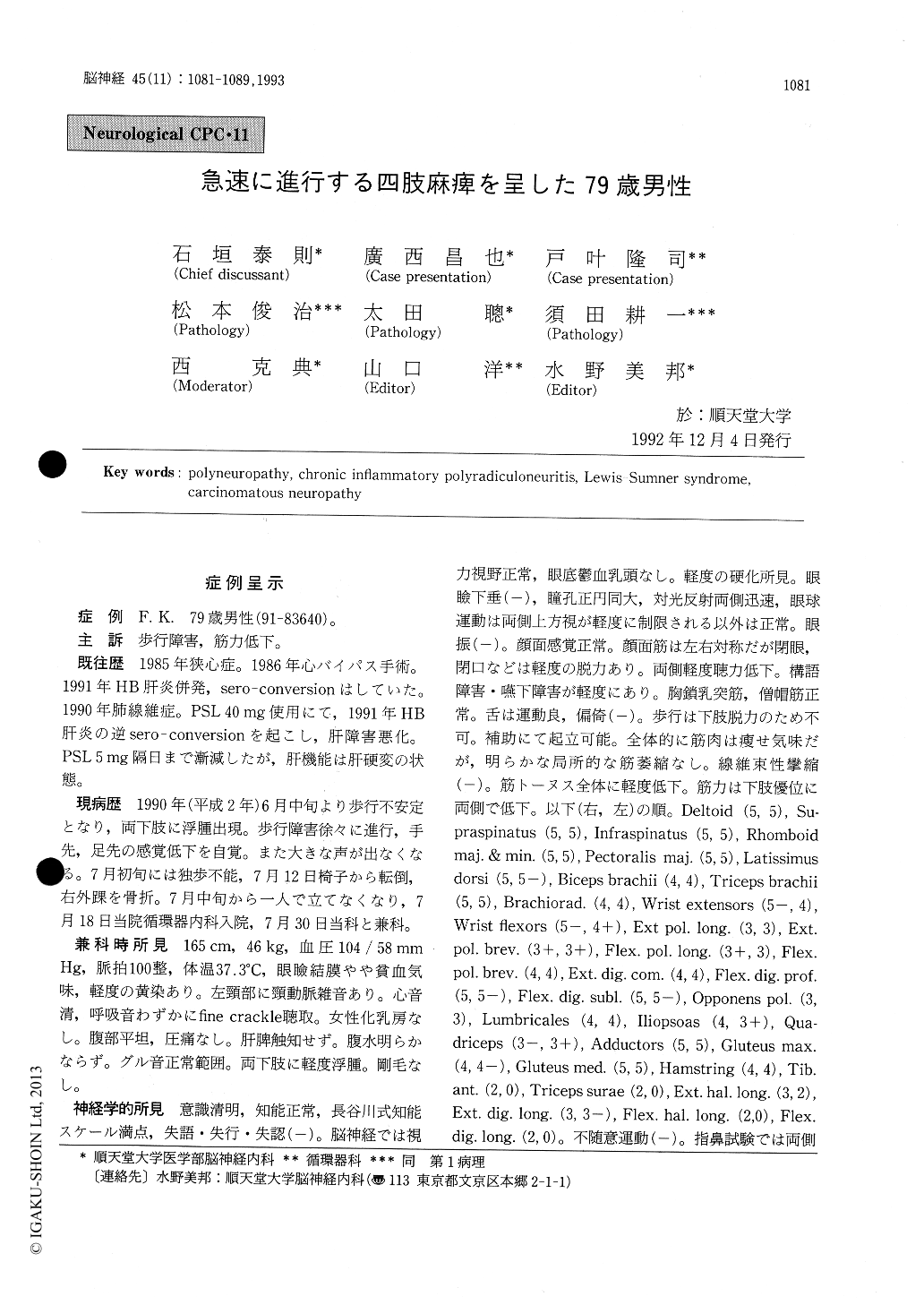Japanese
English
- 有料閲覧
- Abstract 文献概要
- 1ページ目 Look Inside
症例呈示
症例 F.K.79歳男性(91-83640)。
主訴 歩行障害,筋力低下。
We report a 79-year-old man who developed progressive gait disturbance and sensory loss. He had been doing well except for hepatitis B virus hepatitis until 72years of age when he developed angina pectoris for which aorto-coronary bypass operation was performed when he was 73-year-old (1986). In 1990, he developed pulmonary fibrosis for which prednisolone was prescribed. His liver func-tion deteriorated, and the liver function tests sug-gested liver cirrhosis. He noted an onset of gait disturbance in the middle of June in 1992 when he was 79-year-old. His gait disturbance deteriorated progressively, and he developed edema and loss of sensation in his both legs. He became unable to walk unassisted in the beginning of July. He fractured his right external malleorus after falling down from a chair. He became unable to stand byhimself, and he was admitted to the cardiology service of our hospital on July 18, 1992, and the neurology service was asked to see the patient on July 30 of the same month.
The patient was well developed and well nouri-shed man in no acute distress. General physical examination revealed slight jaundice, left carotid bruit, and slight pitting pretibial edema. His tem-perature was 37.3℃. On neurologic examination, he was alert and mentally sound without dementia. He showed a slight weakness in the facial muscles bilaterally and mild dysarthria and dysphagia, how-ever, the other cranial nerves appeared intact. He was unable to stand unassisted. The muscle tone was hypotonic, however, no focal muscle atrophy was noted, nor was observed fasciculatory twitches. His muscle strength was moderately reduced more on the distal parts in both upper and lower extrem-ities bilaterally. Evaluation of ataxia appeared to be difficult because of weakness. All the deep ten-don reflexes were lost. No pathological reflex was elicited. Paresthesia was present in the glove and stocking distribution, but pain sensation was preser-ved. Light touch was diminished in the left L-4 dermatom. Vibration was lost in both feet, and the position sense was diminished in the left foot. The autonomic nervous system appeared intact.
Laboratory examination revealed normochromic anemia and slight increase in serum creatinine level (1.5mg/dl). The liver function profile appeared unremarkable. Cerebrospinal fluid protein was in-creased to 113mg/dl. Motor nerve conduction velocity was diminished in both upper and lower extremities, more in the legs. Myelography on July 31 revealed a protrusion of the disc between the fourth and the fifth lumbar vertebra. Because of hepatitis B, a long-term use of prednisolone was impossible. Plasmapheresis could be performed only twice because he refused further plasma exchange. His weakness rapidly progressed and dysphagia became more prominent. On the 13th of September, 1992, he was found in a state of cardiac arrest. Resuscitation was unsuccessful.
He was discussed in a neurological CPC, the chief discussant arrived at a conclusion that he had chronic demyelinating polyradiculoneropathy (CIDP), although the clinical course appeared too rapid compared with typical cases of CIDP.
Postmortem axamination revealed demyelination of posterior roots and pallor of the posterior column in the K-B staining. Mild cellular infiltration was noted in the perivascular space and along the nerve fibers of the posterior roots, which were consistent with the pathological diagnosis of CIDP.

Copyright © 1993, Igaku-Shoin Ltd. All rights reserved.


